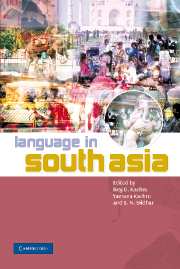Book contents
- Frontmatter
- Contents
- List of Figures
- List of Maps
- List of Tables
- Preface
- Acknowledgments
- List of Abbreviations
- Note on Transcription
- Introduction: languages, contexts, and constructs
- Part 1 Language history, families, and typology
- 1 Language in historical context
- 2 Typological characteristics of South Asian languages
- Part 2 Languages and their functions
- Part 3 Sanskrit and traditions of language study
- Part 4 Multilingualism, contact, and convergence
- Part 5 Orality, literacy, and writing systems
- Part 6 Language conflicts
- Part 7 Language and modernization
- Part 8 Language and discourse
- Part 9 Language and identity
- Part 10 Languages in diaspora
- References
- Subject Index
- Language Index
- Author Index
1 - Language in historical context
Published online by Cambridge University Press: 04 May 2010
- Frontmatter
- Contents
- List of Figures
- List of Maps
- List of Tables
- Preface
- Acknowledgments
- List of Abbreviations
- Note on Transcription
- Introduction: languages, contexts, and constructs
- Part 1 Language history, families, and typology
- 1 Language in historical context
- 2 Typological characteristics of South Asian languages
- Part 2 Languages and their functions
- Part 3 Sanskrit and traditions of language study
- Part 4 Multilingualism, contact, and convergence
- Part 5 Orality, literacy, and writing systems
- Part 6 Language conflicts
- Part 7 Language and modernization
- Part 8 Language and discourse
- Part 9 Language and identity
- Part 10 Languages in diaspora
- References
- Subject Index
- Language Index
- Author Index
Summary
Introduction
South Asia is often described as a linguist's paradise. While it is not the only region of the world to merit such a label, there are several clear reasons for this: the number of different languages spoken is very large (though less than the figure of 1,652 listed in the 1961 Census for India and even than the 1,018 classified by the same Census as indigenous); there are linguistic records, in the form of both inscriptions and texts, going back considerably more than three millennia; there are the inscribed remains, from the ancient civilization of the Indus valley, of a language that has yet to be deciphered to the full satisfaction of the world of scholarship; there are literary languages side by side with languages that lack a writing system; two dozen writing systems are in use; many of the languages exhibit diglossia; and there is, and has long been, widespread bi- and multilingualism, both individual and geographical. Indeed, bilingualism, rather than monolingualism, is the norm.
It is impossible to be at all precise about either the number of languages spoken in the region or the number of speakers of each. There are several well-rehearsed reasons for this: the status of a given language variety – whether it is more appropriately regarded as a language in its own right or as one of a number of dialects of a language – is not always clear; some languages still may remain to be discovered; available statistics vary in quality, reliability, and date; there has been a tendency in recent national censuses to disregard figures for languages with less than a certain minimum of recorded speakers; political factors may be involved in the question of which languages are recognized and in the manner in which different language varieties are grouped together.
- Type
- Chapter
- Information
- Language in South Asia , pp. 31 - 48Publisher: Cambridge University PressPrint publication year: 2008
- 5
- Cited by



